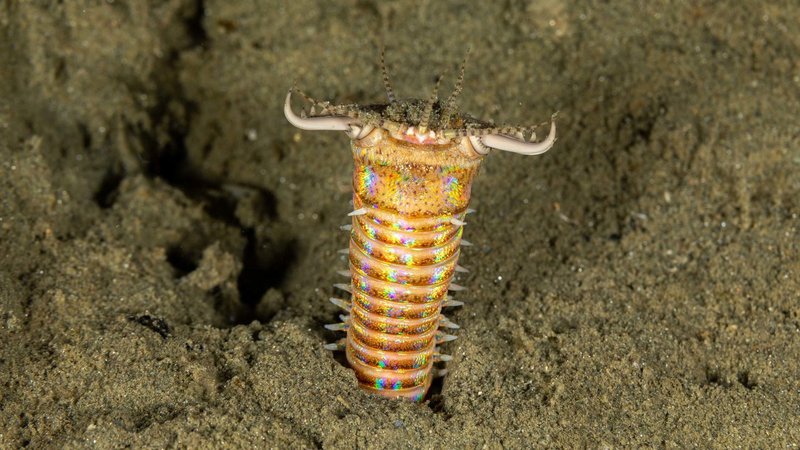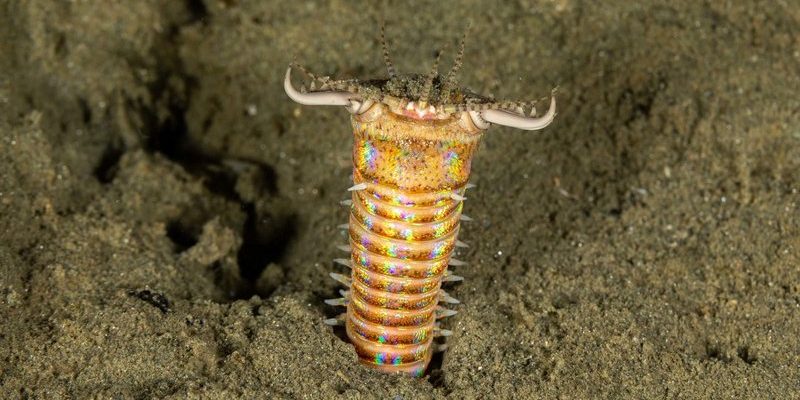
Bobbit worms, known scientifically as *Eunice aphroditois*, can grow up to ten feet long. Think of them as the warriors of the seafloor, lying in wait to ambush unsuspecting prey. But just like many other species, they have left their mark in the fossil record, giving us a glimpse into ecosystems long past. As someone who’s always enjoyed exploring the mysteries of nature and history, I find it remarkable how these creatures have survived millions of years—through ice ages and planetary changes—while still being fundamental to marine biodiversity today.
What Are Bobbit Worms?
Bobbit worms belong to the class Annelida, which includes other segmented worms like earthworms and leeches. Unlike their more familiar relatives, Bobbit worms are equipped with sharp, powerful jaws that they use to snag prey like fish and crustaceans. Picture them as stealthy ambush predators, blending into their surroundings until the perfect moment strikes. They usually live in burrows on the ocean floor, where they can lie in wait for hours—even days—before launching a quick strike.
Their striking colors, ranging from bright greens to vivid reds and blues, make them incredibly eye-catching. You might be wondering how they fit into the ecosystem. Bobbit worms play a key role in maintaining the balance of marine life. They’re not just predators; they also contribute to the energy flow within their habitats. The nutrients they help cycle can support an array of other marine life, creating a thriving ecosystem.
While you might think of these worms as modern marvels, their ancestry is rich with history. Fossil evidence suggests that their ancestors lived during the Cambrian period, over 500 million years ago. Isn’t it fascinating how life can endure so long, adapting and evolving into the forms we recognize today?
The Fossil Record of Bobbit Worms
When we talk about the fossil record of Bobbit worms, we’re diving into a rich history filled with discovery and intrigue. Fossils allow us to piece together the ecological narratives of the past, helping us understand how organisms responded to environmental changes over time. For Bobbit worms, their fossils are typically found in sedimentary rock formations, often near marine environments where they once thrived.
The fossils themselves may not look like the colorful worms we see today. Instead, they often appear as elongated, segmented tubes or hardened remnants of their bodies. These fossils can provide insights not just into the worms themselves, but also into the conditions they lived in. You might find fossils of related species that help us understand how these ancient annelids interacted with their ecosystem and what other life forms shared their habitat.
Most notable Bobbit worm fossils have been discovered in regions that were once covered by ancient seas. These fossils tell scientists about the diversity of life at different geological points. Additionally, they help us understand how climate shifts or geological events influenced marine ecosystems. The study of these fossils can show us patterns of survival or extinction that resonate even today.
The Importance of Fossils in Studying Annelids
Fossils play a critical role in understanding the evolutionary history of Bobbit worms and other annelids. By examining these ancient remnants, paleontologists can trace the physical changes in the species and their adaptations over time. This is essential for piecing together the evolutionary tree, showing how different species are related and how they adapted to their environments.
In addition to understanding species evolution, fossils help scientists determine how ecosystems respond to changes. For instance, shifts in carbon dioxide levels or temperature can lead to mass extinctions or sudden bursts of biodiversity. By studying the fossil record of Bobbit worms, researchers can see how these marine predators adapted—or didn’t—to past environmental stresses. It’s a bit like playing detective, putting together clues from the Earth’s history.
Moreover, Bobbit worm fossils can shed light on ancient ocean environments. Fossils provide context about the sediment where they were found, which can indicate factors like ocean salinity, depth, and temperature. This, in turn, helps scientists predict how current underwater ecosystems might respond to ongoing climate change.
How Have Bobbit Worms Evolved Over Time?
Evolution is a fascinating journey. Bobbit worms have been around for millions of years, which raises the question: how have they changed? Through the fossil record, we see evidence of some changes in size, shape, and behavior. Early ancestors may have looked quite different, adapting as their environments shifted.
Some researchers believe that their hunting techniques have evolved too. Today’s Bobbit worms are expert ambush predators, but their ancestors might have employed different strategies, reflecting their ecosystems’ demands. By examining fossilized remains and comparing them to modern specimens, scientists can track these shifts and understand the pressures that led to their current forms.
Interestingly, Bobbit worms are often seen as “living fossils.” This means they have maintained many features over millions of years, suggesting that their design is highly effective. Think of it like the classic design of a successful vehicle—why change it if it works? Nonetheless, even these ancient annelids have seen subtle changes, and ongoing research continues to reveal the depth of their evolution.
The Role of Bobbit Worms in Today’s Ecosystems
Today, Bobbit worms are vital components of marine ecosystems. They help control populations of smaller marine animals, which maintains balance in the food web. Their burrowing activities also aerate and enrich the sediment, which benefits many organisms living in or on the ocean floor. It’s like they’re nature’s little gardeners, assisting in the overall health of their environments.
Moreover, Bobbit worms are often indicators of ecological health. A thriving population can signal a balanced ecosystem, while a decline may indicate environmental stress. By studying these creatures, scientists can gather data about water quality, habitat integrity, and climate impacts.
As we face pressing environmental issues like climate change and pollution, understanding Bobbit worms and their roles in ecosystems becomes increasingly important. Their ancient history provides insight into how marine life can adapt, survive, and thrive amid challenges. In a way, they serve as reminders of nature’s resilience and adaptability.
Bobbit worms offer an amazing look into the ancient world, as well as a better understanding of our current ecosystems. Their striking presence in the fossil record allows us to piece together stories of survival and adaptability. It’s incredible that something so small has played such a significant role over millions of years, serving as a reminder of the interconnectedness of life.
Whether you’re a marine biologist or simply someone with a curious mind, exploring the world of Bobbit worms and their fossils can be both enlightening and inspiring. Fossils, after all, are more than just relics of the past—they’re windows into Earth’s history and teachers of adaptation. Next time you think about the ocean, consider the Bobbit worms beneath the waves; they might just be the unsung heroes of the underwater realm.

